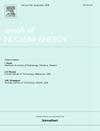A semi-implicit Chord Length Sampling method for dispersion fuel analysis
IF 1.9
3区 工程技术
Q1 NUCLEAR SCIENCE & TECHNOLOGY
引用次数: 0
Abstract
With the advent of stochastic geometry in nuclear reactors, implicit modeling processes play an increasingly important role in the precise simulation of particle transport in random media. Current implicit modeling methods in RMC utilize Chord Length Sampling (CLS). However, the CLS method experiences significant inaccuracies compared to explicit modeling methods when simulating materials of high scattering and absorbing properties, particularly where absorption interferes with scattering, and is especially prone to errors when simulating non-Markovian stochastic media. A Semi-Implicit CLS (SCLS) method is proposed where previous neutron and particle positions are recorded, while an inclusion sphere is used to maximize the accuracy of the method whilst minimizing the computational expense incurred. The accuracy of the algorithm was then verified against particle distributions generated via explicit modeling methods. The results show that SCLS can significantly improve the accuracy of implicit modeling when simulating non-Markovian dispersion fuel compared to the original CLS method.
用于分散燃料分析的半隐式弦长取样法
随着核反应堆随机几何的出现,隐式建模过程在粒子在随机介质中输运的精确模拟中发挥着越来越重要的作用。目前RMC中的隐式建模方法采用弦长采样(CLS)。然而,与显式建模方法相比,CLS方法在模拟高散射和吸收特性的材料时存在显著的不准确性,特别是在吸收干扰散射的情况下,并且在模拟非马尔可夫随机介质时特别容易出错。提出了一种半隐式CLS (SCLS)方法,该方法记录了之前的中子和粒子位置,并使用包含球来最大化方法的精度,同时最小化计算费用。然后通过显式建模方法生成的粒子分布验证了算法的准确性。结果表明,与原有的CLS方法相比,该方法在模拟非马尔可夫分散燃料时可以显著提高隐式建模的精度。
本文章由计算机程序翻译,如有差异,请以英文原文为准。
求助全文
约1分钟内获得全文
求助全文
来源期刊

Annals of Nuclear Energy
工程技术-核科学技术
CiteScore
4.30
自引率
21.10%
发文量
632
审稿时长
7.3 months
期刊介绍:
Annals of Nuclear Energy provides an international medium for the communication of original research, ideas and developments in all areas of the field of nuclear energy science and technology. Its scope embraces nuclear fuel reserves, fuel cycles and cost, materials, processing, system and component technology (fission only), design and optimization, direct conversion of nuclear energy sources, environmental control, reactor physics, heat transfer and fluid dynamics, structural analysis, fuel management, future developments, nuclear fuel and safety, nuclear aerosol, neutron physics, computer technology (both software and hardware), risk assessment, radioactive waste disposal and reactor thermal hydraulics. Papers submitted to Annals need to demonstrate a clear link to nuclear power generation/nuclear engineering. Papers which deal with pure nuclear physics, pure health physics, imaging, or attenuation and shielding properties of concretes and various geological materials are not within the scope of the journal. Also, papers that deal with policy or economics are not within the scope of the journal.
 求助内容:
求助内容: 应助结果提醒方式:
应助结果提醒方式:


